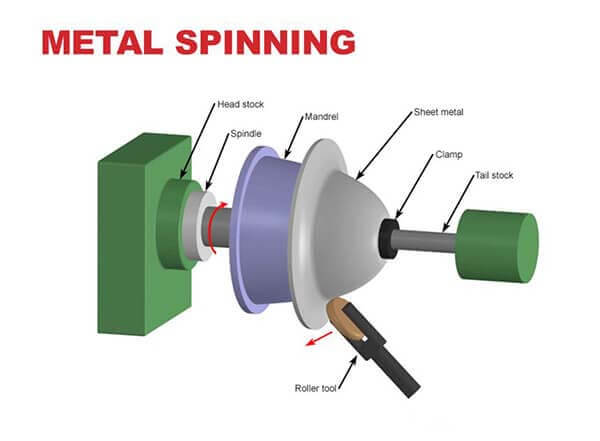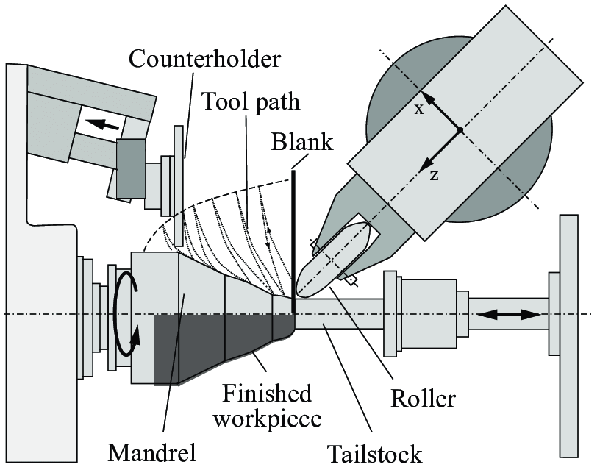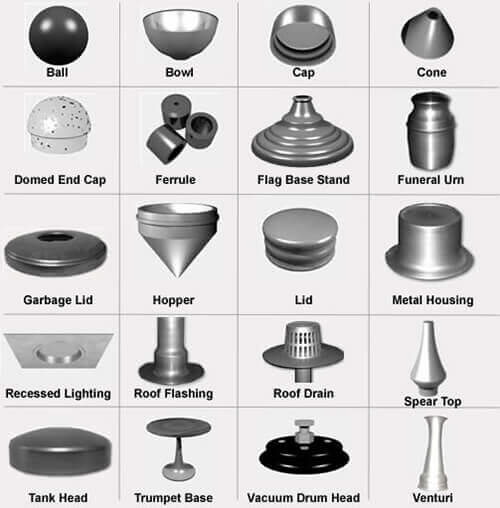
What is Metal Spinning?
Metal spinning is an industrial process that is used for processing metals into a spinning form. The process entails rotating or spinning a disc or tube metal at high speed. As the rotation takes place, the metal is converted into a symmetric part.
Unlike the popular assumption, metal spinning does not involve the removal of the material from the workpiece. Instead, the metal is physically molded into the desired shape with minimal destruction of the material.
Metal spinning can be performed manually or through a CNC lathe machining process. You should also know that there are many different methods of metal spinning while at the same time, different types of metals can be subjected through this process.
The process fundamentals are simple. A round blank, flat or preformed, is fixtured during a spinning lathe. As the blank spins, a roller tool forms around it.
Usually, as the blank is pressed against a mandrel, the grain structure is compressed, producing a smooth surface that always doesn’t require any other form of secondary finishing.
The methods of metal spinning can vary depending on the complexity of the part that is being processed. This also applies to the cost of the metal spinning lathe. Some techniques will attract a higher cost than others.
History Of Metal Spinning
Metal spinning has quite a rich history. It is assumed that the potters’ wheel of the traditional Egyptians provided the idea for the spinning process. This is despite the fact that primary evidence of metal spinning techniques getting used for the forming of metals occurs within the middle ages.
Evidence of the spinning process is also provided by an old wood carving, which shows a metal spinner engaged within the production of what are obviously metal vessels.
Some of the materials that were spun during those ancient days include wood, bronze, stone, amber, among others.
Development to the modern age
The major development in spinning and lathe add the Middle Ages was the introduction of technology that allowed workers to continuously rotate materials.
This technology was mainly attained by replacing the bow with the pedal. Moving the pedal with one’s feet freed the worker’s hands to regulate the speed of rotation and specialize in accuracy and precision.
The lathe unit also became more compact, manifesting as a small disk-shaped station for machining.
The worker stamped on the pedal, or foot treadle, which rotated an outsized flywheel, resetting the action of the treadle and allowed the worker to down thereon as endless action.
Viking and other societies didn’t develop this continuous action until later, although they did use pedal-driven lathes. Here, poles were used to reset the treadle in the lathe, but because this activity reversed the rotation direction, chiseling could only occur during one motion. Pole lathes were easy to supply and really common, even up until the 20th Century.
Eventually, iron lathes were constructed for denser materials. These lathes varied in size but worked similarly to the sooner copper and wooden lathes. Iron lathes might be made very precise, creating a delicate clock and watch parts.
The invention of the electric motor is credited for spearheading the metal spinning industry to a completely new level. It provided the basis for running most modern metal spinners and also made hand spinning redundant. The process can be carried out with total ease.
Industrial metal spinning is done by the CNC machining systems. Apart from increasing the production volumes, these machines are automated and are more accurate.
Metal Spinning Process

How is metal spinning done? Here is a summary of how metal spinning is carried out:
The first step of the process entails mounting a block onto the drive section of the lathe. From there a pre-sized disk-shaped metal is clamped against this clamp with the help of a pressure pad.
The clamped block and the workpiece are then rotated at high speed. Localized or concentrated force is then exerted on the workpiece so that it can flow over the block. Various metal spinning tools generate the force.
Some workpieces are then removed from the block while other complex workpieces are channeled to the multi-piece blocks. More complex pieces are spun over the ice forms.
Regardless of the case, the diameter of the workpiece will always be smaller than the initial diameter when you started working on the piece. This makes it necessary for the workpiece to be thickened or elongated o compensate for the reduction.
Another process known as necking or reducing is done to allow the workpiece to alter its geometries. During the entire process, very little attention is given to the surface finish of the metal.
Hot Spinning
Hot spinning refers to the process of spinning a piece of metal on a lathe while a high beam of heat is directed to the workpiece. After the workpiece is heated, the subject metal is then shaped whereby the lathe is pressed against the heated surface. Necking or reduction of the diameter can still be achieved through the hot spinning technique.
Multipass spinning vs Shear Metal Spinning
Although metal spinning is designed to achieve one common goal, the steps and techniques used are not always the same. This means that there are different iterations of this process.
The most common iteration of metal spinning is the multipass spinning. This is where the roller of the spinning tool rolls over the disc several times shaping your metal so that it takes the shape of the mandrel.
Another common type of metal spinning is known as shear spinning. Here, a part of the metal is finished with just a single pass. The shear spinning roller presses against the metal using a unique technique giving it the desired shape. Shear forming can also be done on a manual machine.
Both the multipass and the shear spinning can be done on the same machine. The difference is the impact that the spinning process will have on the metallurgical metal. Also, both the methods of metal forming have a direct impact on the thickness of the metal.
A Video illustration of metal spinning
Metal Spinning Tools
Another essential aspect of this metal forming method is choosing the right metal spinning tools. If you are planning to go for the manual metal spinning method, then you should aim at choosing the right tools for the job.
The primary tool for metal spinning is always referred to as a spoon. There are many other improvised tools that can still be used for the job.
Most metal spinning tools are made from hardened steel though there are some that are made from solid brass.
In almost all situations, metal spinning tools are designed to spin on the bearing. This is done with the aim of improving the surface finish of the metal while at the same time increasing the durability of the tool.
As the spinning tool rotates, the heat and friction that are generated during the process tend to be greatly minimized.
In recent years, CNC machines are replacing most tools for spinning due to their high levels of accuracy and efficiency. The rollers that are used in the CNC machines come in different diameters. It all depends on the application of the metal to be spun.
Cutting tools also form part of the CNC tools. They are essential since some metals may have to be cut after they have been spun. A significant percentage of the cutting tools for metal spinning is made of carbide.
Advantages of Metal Spinning
Still, wondering whether you should consider metal spinning services? To bring this matter to a halt, here are the top advantages of spun metal;
Time-saving: Through metal spinning, several metal forming operations can be performed under one operation. This will reduce the time frame that you need for the production process.
Strong metals: The spun metals tend to be strong, tough, and resilient. This is due to the repeated impact force that these metals are subjected to during the metal spinning process.
Less wastage: As compared to other methods of metal forming, metal spinning does not cause any significant wastage of the material.
Less post finishing process: Spun metals don’t need to be subjected to numerous post-finishing processes.
Versatile: Metal spinning can be used on different types and sizes of metals. You can opt for this method regardless of the size of metal. Also, different shapes can be obtained from this process.
Cost-effective: Metal spinning services are cheaper than most alternative methods of metal forming. You are likely to pay less for quality work. Of course the secrete to this is choosing affordable metal spinning companies.
From this list, it is clear that metal spinning is not something that you can easily ignore.
Metal Spinning Products and Applications

The metal spinning process has a wide range of applications. Basically, you can easily identify products of metal spinning by observing their shapes.
Some of the common shapes of metal spinning include;
-Conical
-Spherical
-Semi-spherical
-Parabolic
-Venturi
-Cylindrical
-Toroidal
In relation to that, there are different types of metals that are used for spinning. They include;
-Stainless steel
-Copper
-Aluminum
-Carbon steel
-Titanium
-Brass
From the above shapes and lists, we can easily list products such as automotive parts, gas cylinders, satellite dishes, cookware, among others. This list also shows that the applications of metal spinning spread across different industries.
Copyright © Jiangsu Hoston Machine Tools Co., Ltd. (Hongkong Hoston Group CO., LIMITED)All Rights Reserved | Sitemap Technical Support: 